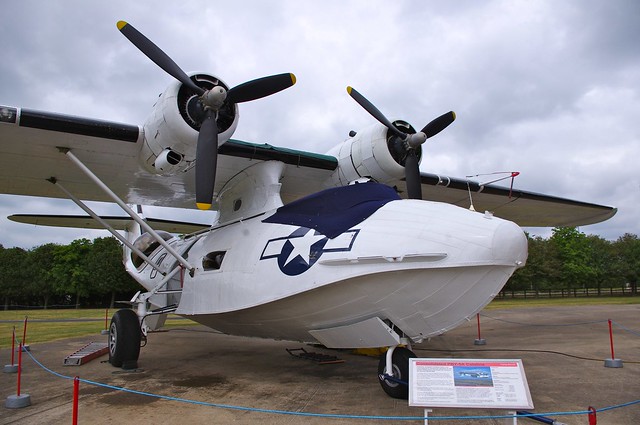Just like in my Tiger Moth training, doing circuits to practise taking off and landing is a big part of the training. Changing aircraft is almost like starting again: the Tiger Moth likes a very steep, gliding approach, so it makes the circuit a quite different shape to a faster aircraft on a powered approach. So after my change, I've got a lot more touch-and-go landings ahead of me.
 |
| Duxford's modern tower. Photograph courtesy Glyn Baker, CC. |
The price isn't the only difference to get used to. Unlike Cambridge, which has a full ATC tower, Duxford only has a Flight Information Service (FIS), which makes the radio etiquette somewhat different. I still have to call downwind and final, but the FIS can't give me clearance to land, or any other instructions.
Although most aerodrome circuits are the same shape, there are a couple of local features at Duxford that add challenge. On my climb-out from the runway 06, I have to turn 5-10 degrees to my left, to avoid overflying the outskirts of Duxford village. This is to comply with the aerodrome's noise abatement procedure, which helps them to maintain good relations with the villagers. And then instead of performing my right turn as soon as I reach 500 feet, I have to wait until I'm all the way past the village, to make sure I don't overfly it on the crosswing leg either.
Crosswind proceeds as normal, but then there's another complication. Just under where I'd like to turn downwind, there's a gas pumping station. I can't overfly this either, because if there's a gas leak or fire at the station, it could be very dangerous to the aircraft. So I have to look out of my right window to check I've gone past it before I can turn. It's quite hard to see from the left seat until I roll into the turn, but with my right wing low, it's easy to see I'm well away from it.
Once I'm established on the downwind leg, it should be standard from there, but today, there's another aircraft in the circuit with me: a Catalina flying boat. This is a rare and historical aircraft, and the operators have chosen today to practise unusual conditions, such as landing with one engine out. They're right up my bum all the way around the circuit, keeping the pressure on, and with no ATC, there's nobody to ask them to do an orbit for spacing.
 |
| Probably the same ship, as this photo was taken in Duxford. Photo courtesy David Merrett, CC-BY. |
Golf Sierra Echo, final for touch-and-go, runway 06.
Golf Sierra Echo, land at your discretion.
This is what the FIS has to tell me, instead of clearing to land. And because it's not a clearance, I don't need to read it back. Instead, it's quicker to just acknowledge with my callsign: G-SE.
After that it's just a question of flying to the runway threshold and flaring at the right time. Duxford's runway is shorter than Cambridge's, but still more than adequate for a touch-and-go, so it's straight into another circuit.
We flew a few circuits, but then on a downwind leg we saw something unusual: a Spitfire, making a straight-in approach. I'm not happy about his positioning. As he's joining the circuit, he should integrate with the existing traffic, but it looks like he's intending to cut in ahead of us. "I'm going to turn base behind this Spitfire," I say to the instructor, but then the Spitfire comes on the radio and says he's making a fast, low pass to the grass runway, which is to the left of the main runway. This means he can stay ahead of us (because he won't be slowing for the approach) and won't cross our path, so I fly the circuit as normal.
Or so I think. In fact, as we're on final approach, the Spitfire's low approach over the grass runway drifts closer and closer until he's flying directly over the hard runway. Although he's faster than us (so we shouldn't have a chance of hitting him), I can't land when the runway's obstructed like this, so I have to throttle up to full power, raise the nose, raise the flaps, and go around. I'm mentally shaking my fist at this cowboy in a Spitfire, flying in everyone's way, and it feels like I'm back in 1940.
No comments:
Post a Comment